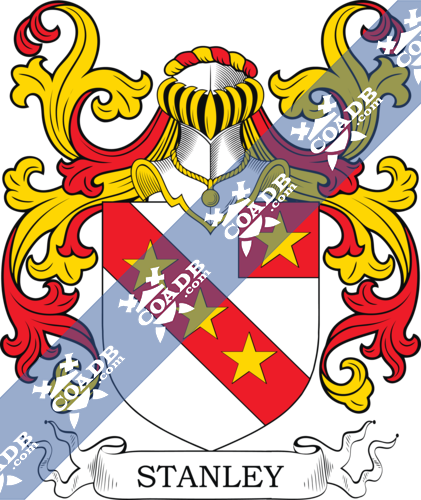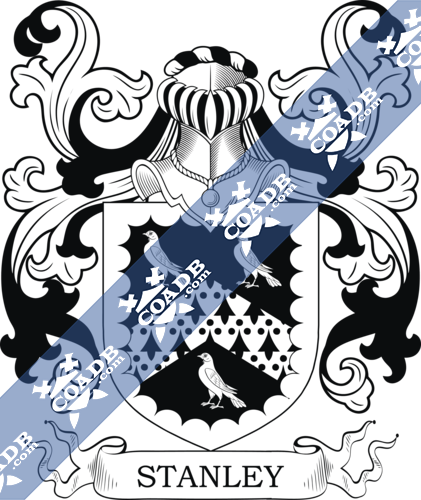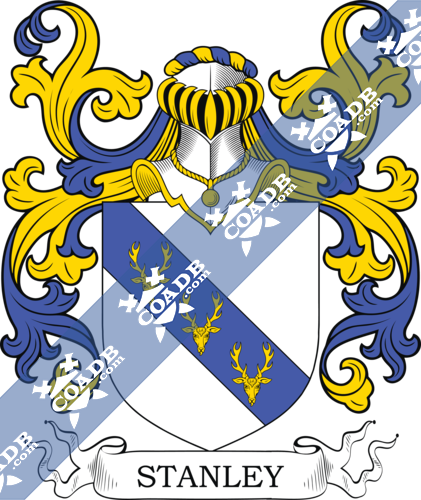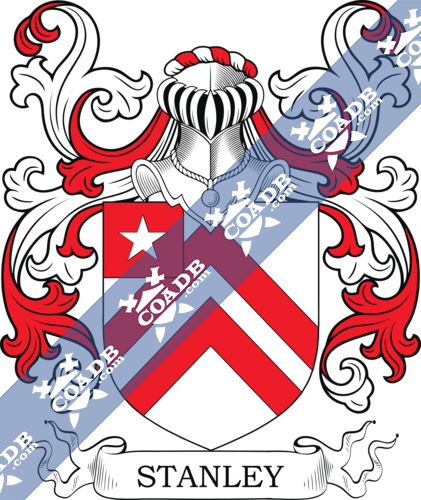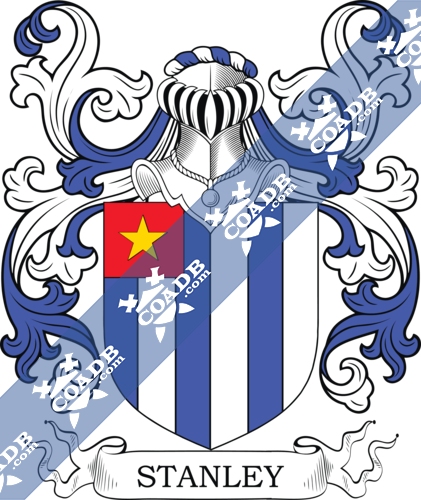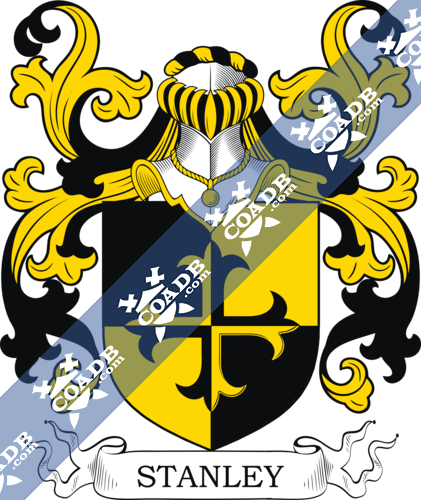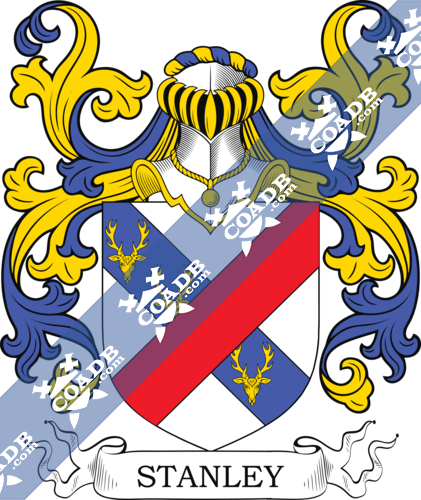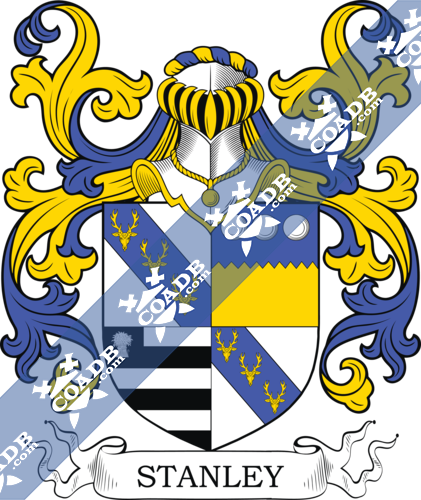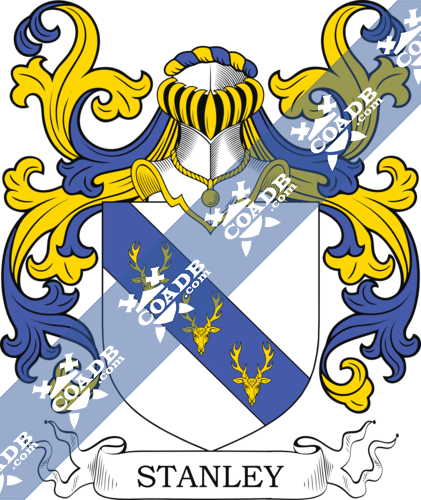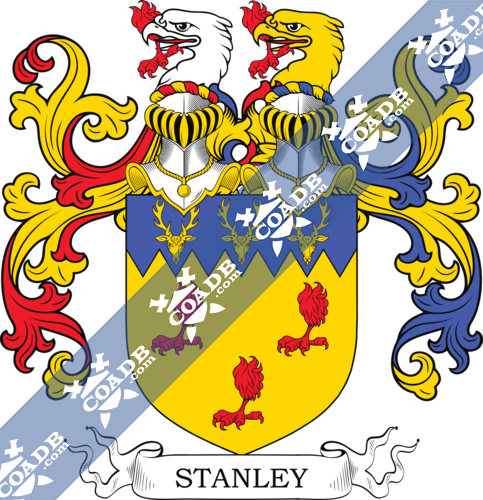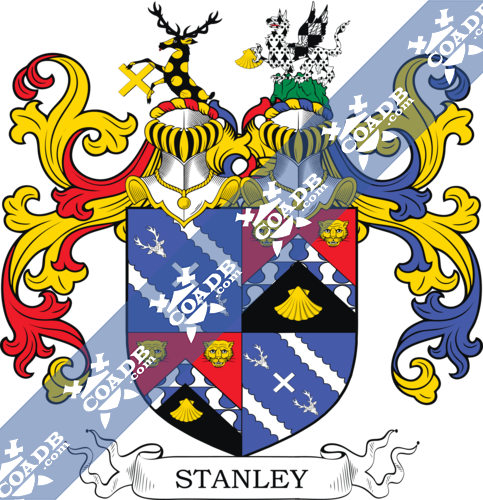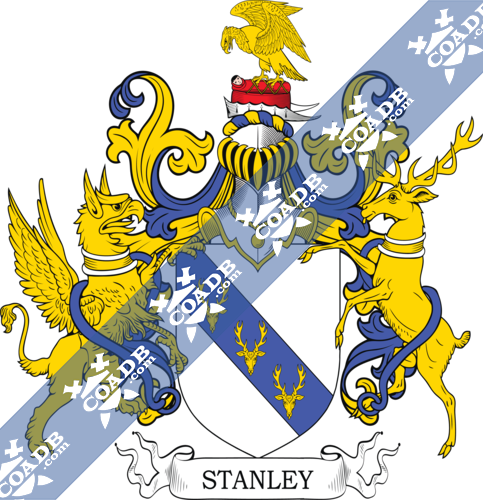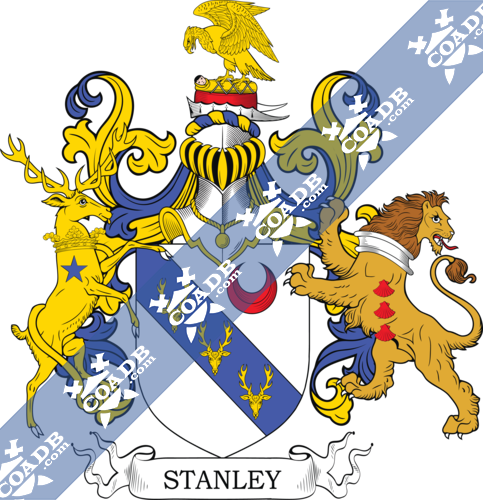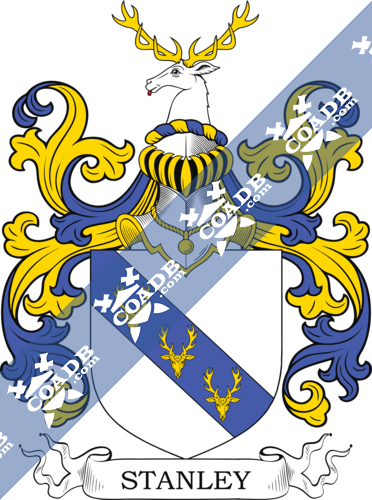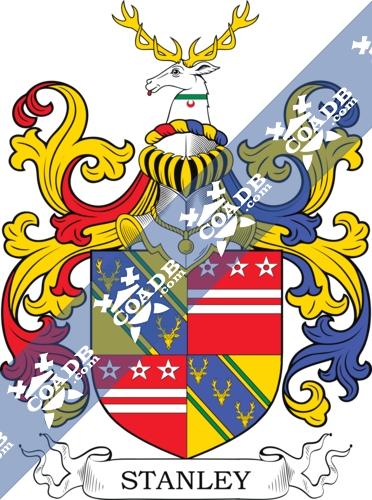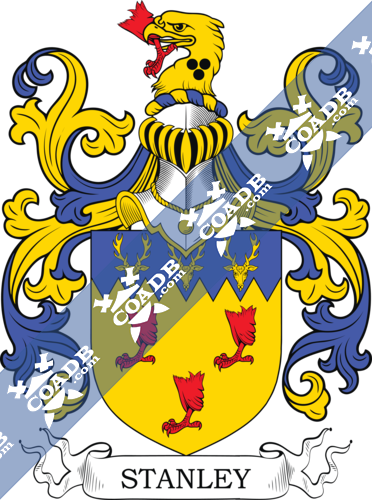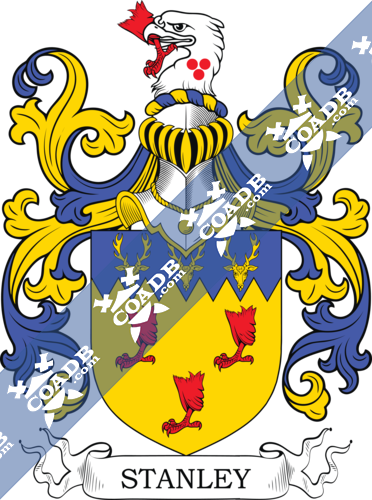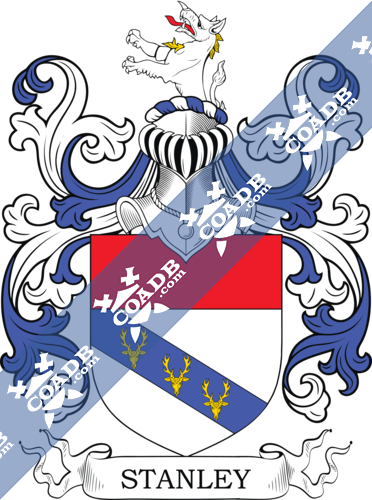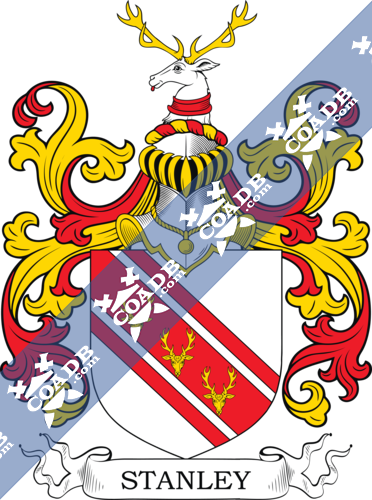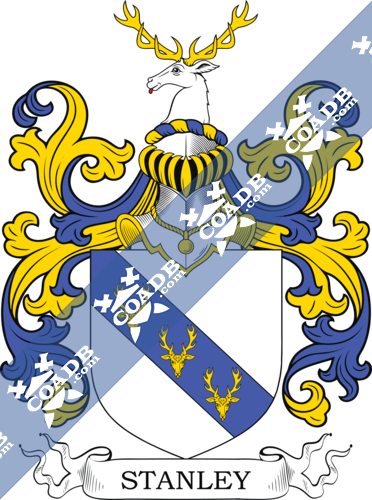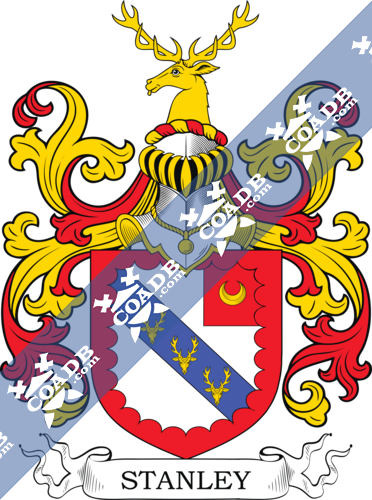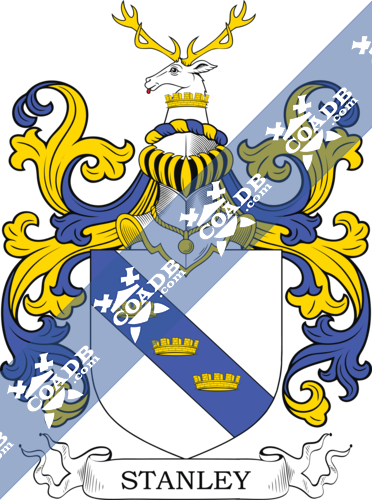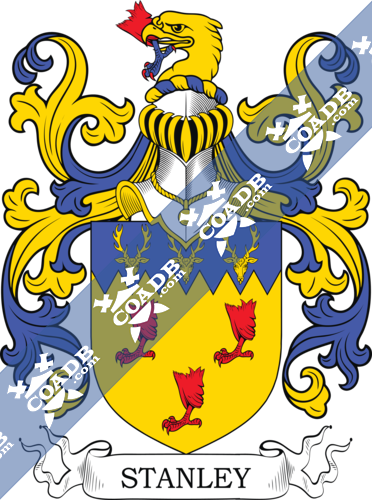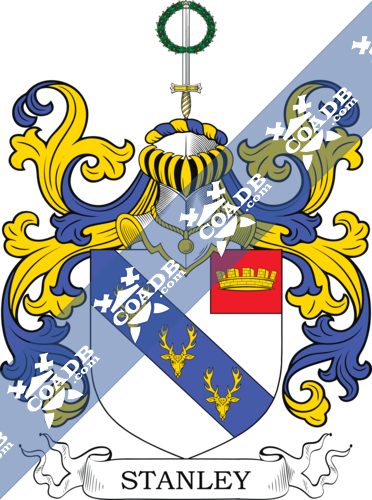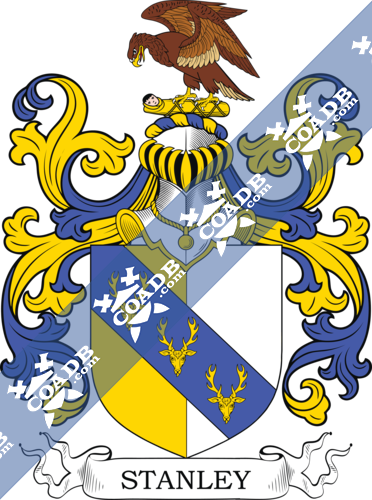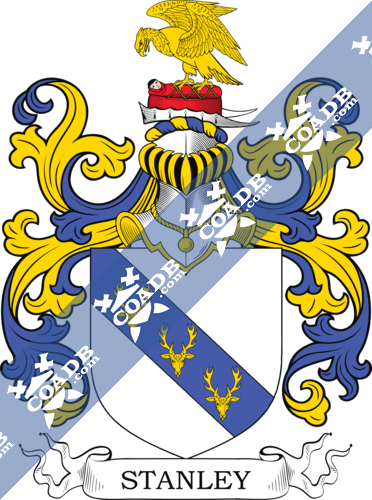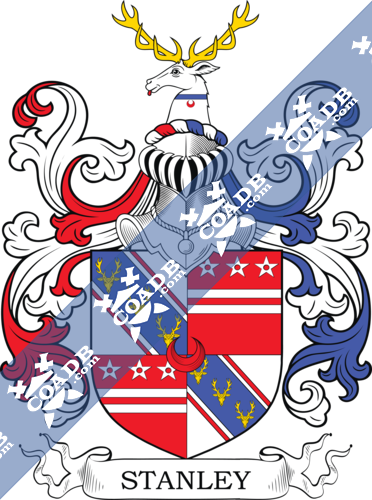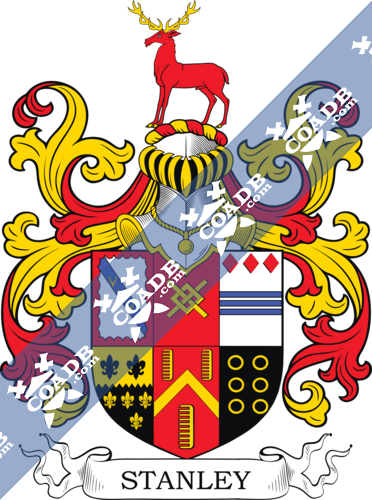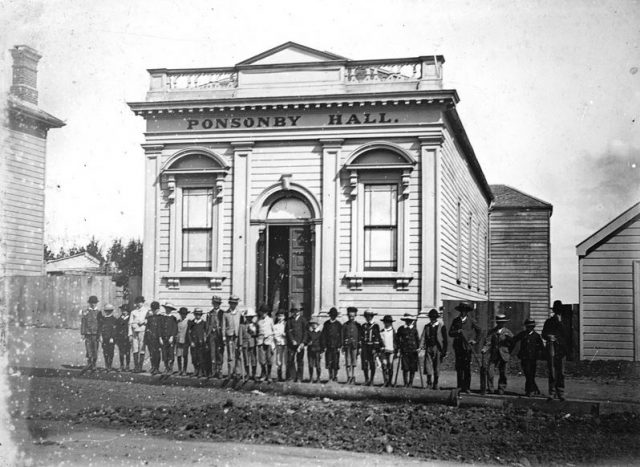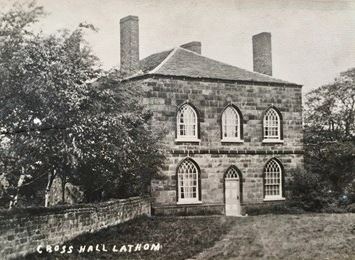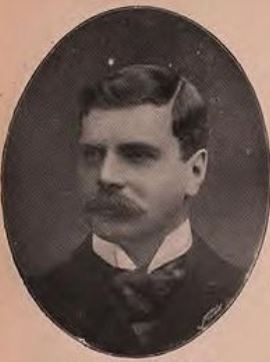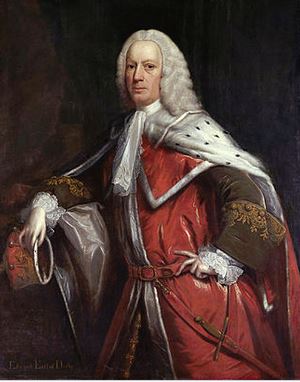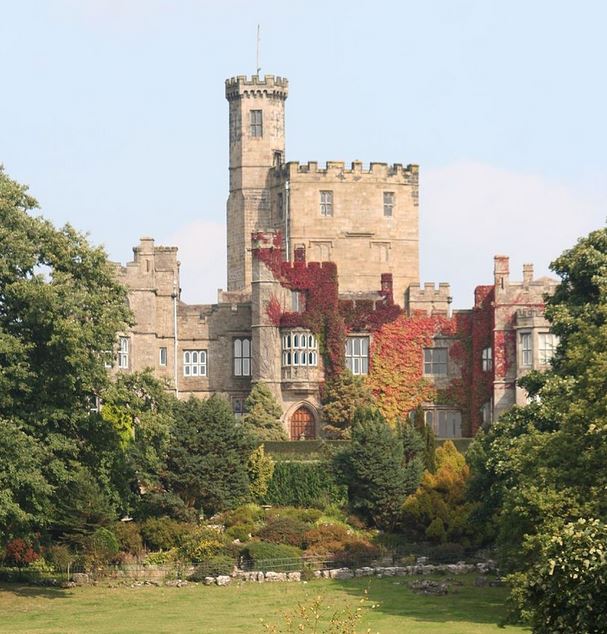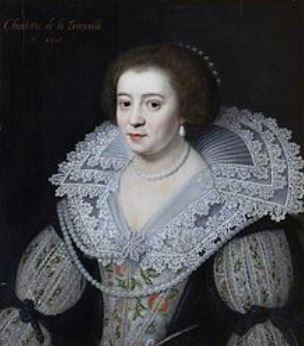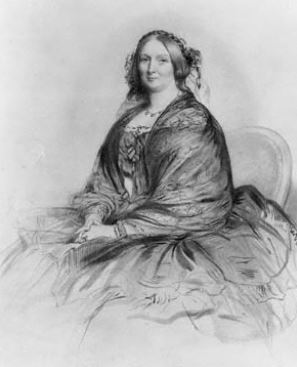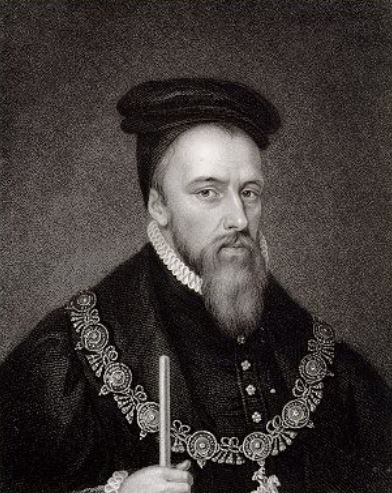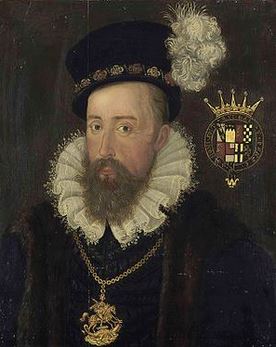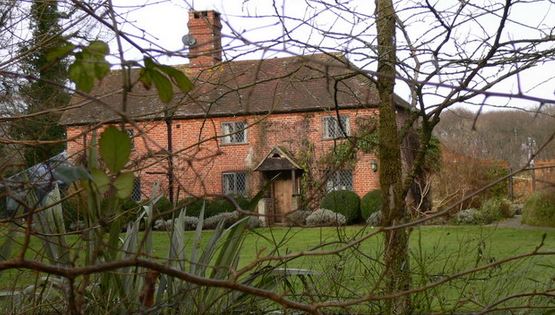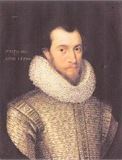Stanley Family Crest, Coat of Arms and Name History
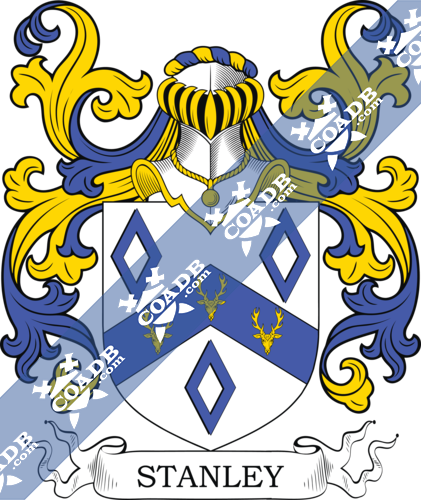
Stanley Coat of Arms Gallery
Don’t know which Coat of Arms is yours?
We can do a genealogical research. Find out the exact history of your family!
Learn MoreStanley Surname Name Meaning, Origin, History, & Etymology
This last name is a locational or habitational name meaning “of Stanley” denoting a person who came from any of the ten parishes of this name in England, including places in Durham, Derbyshire, Staffordshire, Gloucestershire, Wiltshire, and West Yorkshire. The name means “the stony meadow”. It derives from the Old English word stan (stone) and leah (wood or clearing). A second origin theory or meaning of this surname was that it was the place name of a tin mine, deriving from the Welsh for ystaen, meaning tin. Thirdly, In some cases, it is an Americanized form of similar sounding surnames from other European languages, such as the Polish Stanislawksi and the Greek Anastasiou.
The original progenitor of this family was a man named Leofric I, Earl of Leicester, Merica, who was born around 716 AD. His descendant, Adam de Adithley, was a companion of William the Conqueror during the Norman Invasion of England in 1066 AD, and the family held the earldom of Derby subsequently. One source claims the “family’s fortune” was acquired when Sir John Stanley (born 1350 AD) married an heiress of West Derby in Lancashire, England and became Lord Lieutenant of Ireland and received sovereignty over the Isle of Man from King Henry IV of England. One source claims the family first established itself in Cambridgeshire at Stonely, a hamlet next to Kimbolton, the home of Stoneley Priory that was established in 1180 AD.
Spelling Variations
Some spelling variants or names with similar etymologies include Standley, Stanlie, Stainley, Staunley, Staneley, Stanlley, Staynlay, Stanelay, Stanelegh, Stanlegh, and Stanleye.
Popularity & Geographic Distribution
The last name Stanley ranks 292nd in popularity in the United Status as of the 2000 Census. The name ranks particularly high in the following four states: West Virginia, North Carolina, Virginia, and Indiana. The surname Stanley frequency/commonness ranks as follows in the British Isles: England (316th), Scotland (1,036th), Wales (438th), Ireland (505th) and Northern Ireland (1,072nd). In England, it ranks highest in counties Warwickshire and Nottinghamshire. In Scotland, the surname ranks highest in Shetland. In Wales, it ranks highest in county Anglesey. In Ireland, it ranks highest in Queen’s County. In Northern Ireland, it ranks highest in county Armagh. The name is also present throughout the remainder English speaking world: Canada (782nd), New Zealand (426th), Australia (393rd), and South Africa (1,043rd).
Early Bearers of the Surname
A one Robert de Stanleya was documented in the Pipe Rolls of Staffordshire in 1130 AD. The Hundred Rolls of 1273 AD, a census of Wales and England, known in Latin as Rotuli Hundredorum lists two bearers of this surname: William de Stanlegh (Wiltshire) and John de Stanleye (Oxfordshire). The Poll Tax of Yorkshire in 1379 AD lists three bearers of this last name: Johannes de Staynlay, Robertus de Staynlay, and Robertus de Stanelegh. The Register of the University of Oxford records one Edward Stanley on county Lancashire. In Scotland, a one Alexander Stanlie was dean of guild of Edinburgh in 1455 AD and a one Mathew Stanley, a burgess of Edinburgh, was an importer of goods in 1495.
Stanley Family Tree & Stanley Genealogy
The following is a discussion of seven different noble, royal, landed, or aristocratic families bearing this last name.
Stanley of Ponsonby Hall
The lineage or ancestry of the Stanley in England traces back prior to the Norman Conquest of 1066 AD and were first established in Cumberland. John Stanleigh, son of John, Lord of Stanley and Stourton, procured lands at Greswithen in Cumberland and was a Member of Parliament for the city of Carlisle in 1346 AD. His grandson was one Nicholas Stanleigh of Greswithen. Nicholas married Constance, daughter and heiress of Thomas de Awsthawite, Lord Awsthwaite, and acquired that manor (later called Dalegarth) in 1315. In 1388, he purchased the manor of Ponsonby. He was succeeded by his son Thomas. This Thomas Stanleigh, Esq., Lord of Awsthwiate was a Member of Parliament during the reign of King Henry VI of England. He was a son named Nicholas. Nicholas in turn had a son named Thomas. This Thomas Stanley was an Esquire of Dalgarth who married Ann, daughter of Sir Richard Huddleton, Knight. He was succeeded by his son, William Stanley, Esquire of Awsthwaite and Dalegarth, who married Alice, daughter of Sir Richard Ducket, and had a son with her named Thomas. This Thomas married Margaret, daughter of John Fleming, and had children with her: John (his successor), Thomas (of Greswithin, Master of the Mint in 1570), and Mary (married Sir Edward Herbert, Earl of Powis). His son John Stanley, Esq. of Dalegarth, married Isabel, daughter of John Leake of Edmonton, and he was succeeded by his son Edward. This Edward was an Esquire of Dalegarth, who married Ann, daughter and co-heiress of Thomas Briggs of Cawmire, and had a son with her named John. This son John Stanley, Esquire of Dalegarth, was an active and zealous Royalist who married Mary, daughter of Thomas Stanley of Lee in Sussex, and later Dorothy, daughter of Henry Featherstonhaugh. He was succeeded by his son Edward Stanley, Esq. of Dalegarthy, who was a High Sheriff for Cumberland during the Revolution and proclaimed King William III. He married Isabel, daughter of Thomas Curwen of Sella Park, and had a son and successor with her named John. John Stanley, Esquire of Dalegarth and Ponsonby, married Dorothy, co-heiress of Edward Holt of Wigan, and had three sons with her as follows: Edward (his successor), John (Rector of Workington, married Clara Philipson, had son named Edward who married Julia Christian), and Holt (Lieutenant in Brigadier General Wentworth Reigment of Foot, died in the expedition against Porto Bello). His eldest son, Edward Stanley, Esq.,married Mildred, daughter of Sir George Fleming, Baronet, Lord Bishop of Carlisle, and had a daughter and son with her: Dorothy (married Lieutenant Joseph Dacre) and George Edward. His son George Edward Stanley, Esquire of Ponsonby and Dalegarth who was born in 1748 and became a Higher Sheriff. In 1774, he married Dorothy, daughter of Sir William Fleming, Baronet of Rydal, with whom he had the following issue: Mildred, Elizabeth (married John Cumberland Hughes). He secondly married Elizabeth, daughter of Morris Evans of Middlesex, and had three children with her: Edward, George, and Jane. His son and heir, Edward Stanley, was an Esquire of Dalegarth and Ponsonby, was a Justice of the Peace, Deputy Lieutenant, High Sheriff, and Member of Parliament for Cumberland, England (modern day Great Britain and the United Kingdom) who was born in 1790. In 1821, he married Mary, daughter of William Douglas, a Judge in the East Indies, and had eight children with her named as follows: Edward, William (of Dalegarth), George Edward (married Susan Elizabeth Douglas), Douglas Awsthwaite, Jane (married Trevor Barkley, had daughter named Constance), Mary (married Reverend Frederick Guise), Helen (married Reverend Owen W. Davys), and Constance (married J.F. Hewitt and had three issue with him). Edward passed away in 1863. His son William Stanley, Esquire of Dalegarth and Ponsonby, Cumberland, England was born in 1829. In 1859, he married Caroline, daughter of Sir George Musgrave, and had eight issue with her as follows: Edward (1859), William (1861), Philip (1870), Charlotte, Margaret, Lucy Mildred, Constance Madeline, and Caroline Augusta. The Stanley Coat of Arms (mistakenly called the Stanley Family Crest) has the following heraldic blazon: Argent, on a bend azure cotised vert three bucks’ heads caboshed or, quartering the Awsthwaite arms, viz., gules, two bars argent in chief three mullets of six points pierced or. Crest: A stag’s head argent attired or, collared vert. Motto: Sans changer. The family seat was Ponsoby Hall, Carnforth, Whitehaven.
Stanley of Cross Hall
The lineage of this family or Stanley genealogy begins with a discussion of Peter Stanley, son of Sir Thomas, 2nd Baronet of Bickerstaff, who in 1683, married Catherine, daughter of Colonel Alexander Rigby, of Middleton, Goosnargh. He died in 1686 and was succeeded by his son, Thomas. This Thomas was an Esquire of Cross Hall and a High Sheriff in 1718. He married Catherine, daughter of Anthony Parker of Bradkirk, and had five children with her as follows: Rebecca, Mary (married Reverend John Lowe), Thomas (of Cross Hall, Colonel of the 1st Regiment of Royal Lancashire Militia, Member of Parliament), John (officer in the army), James, Betty, and Catherine (married John B. Sawrey Morritt of Rokeby Park). He died in 1746. His son, James Stanley, was an Esquire and Barrister who was born in 1750. In 1786, he married Augusta, daughter of John Cornwall of Hendon, with whom he had the following issue: Edward, Reverend Thomas, Augusta, Elizabeth, and Catherine. His son and heir was Edward Stanley, Esq. of Cross Hall who was a Justice of the Peace and Deputy Lieutenant born in 1789. In 1819, he married Lady Mary Maitland, daughter of James, 8th Earl of Lauderdale, and had three issue with her: Edward James (of Cross Hall), Honorable Eleanor (Maid of Honour to the Queen, married Lieutenant Colonel Long of Bromley Kill, county Kent), and Augusta (married Richard, Earl of Dartrey). His son Edward James Stanley was an Esquire of Cross Hall, county Lancaster, England who was a Justice of the Peace and Deputy Lieutenant born in 1826. In September 1872, he married Mary Lacouchere, daughter and co-heiress of Henry, Lord Taunton, and had three issue with her as follows: Henry Thomas (1873), Edward (1876), and Evelyn Mary (1877). The Stanley Coat of Arms (mistakenly called the Stanley Family Shield by people unfamiliar with genealogy and heraldry) is blazoned as follows: Argent, on a bend azure three stags’ head caboshed or. Crest: On a chapeau gules, turned up ermine an eagle with wings expanded or, preying on an infant proper in its cradle or, swaddled gules banded or. Motto: Sans changer. They family seat was at Quantock Lodge, Bridgwater, Somerset, England, in modern day Great Britain or the United Kingdom.
Stanley of Paultons
The lineage/ancestry of this branch of the Stanley family tree begins with a discussion of Wlliam Sloane-Stanley, Esquire of Paultons and a Member of Paultons, who in 1806, married Lady Gertrude Howard, daughter of Frederick, 5th Earl of Carlisle, having had the following issue with her: William Hans and George Sloane (married Laura Webber of Binfield Lodge, had issue including a son named Francis who succeeded to the Tedworth estate and married Charlotte Rose of Canada, having issue with her named Ronald Francis Assheton, Cecil Fox, and Caroline). William died in 1860. He was succeeded by his son, William Hans Sloane-Stanley, who was an Esquire of Paulston, Hantshire, England and High Sheriff who, in 1834, married Norah, daughter of General Joseph Gubbins, having a son with her named Hans. In 1866, this Hans married Emilie Jospehine, daughter of Francis Edwards of Pickerage, Buckinghamshire. The family was seated at Paultons, near Romset, Hantshire, England in modern day United Kingdom.
Stanley of Longstowe Hall
The lineage, ancestry, or genealogy of this branch of the family tree begins with Sidney Stanley, Esquire of Longstowe Hall, county Cambridge, M.A., who was a High Sheriff, Justice of the Peace, Deputy Lieutenant and Captain of the 1st Hunts Light Horse (Duke of Manchester’s) who was born in December of 1828. In 1859, he married Sarah, daughter of Charles Wenworth , and had twelve children with her as follows: Charles Wentworth (born 1860), Alan Sidney Wentworth, Herbert Foster Wentworth, Guy Wentworth, John Cyrill Wentworth, Maurice William Wentworth, Ethel Wentworth Stanley, Ada Ellen Wentworth Stanley, Grace Wentworth Stanley, Constance Eva Wentworth Stanley Stanley, Florence Howard Wentworth Stanley Stanley, and Winifred Wentworth Stanley Stanley. He was the son of William Wentworth of Cambridge who died in 1832 and Mary Ann Newport. He assumed the name (and arms?) of the last name Stanley in place of his patronymic by loyal license in the year of 1856. The Stanley Arms (erroneously called the Family Crest) has the following heraldic blazon: Quarterly, 1st and 4th, azure, a saltire between two stags’ heads caboshed bendwise between two bendlets engrailed argent, for Stanley; 2nd and 3rd, per chevron gules and sable a chevron nebulae between two leopards’ faces in chief and an escallop in base or, for Wentworth. Crests: 1st: Stanley: A demi stag sable bezantee holding between the legs a saltire or; 2nd, Wentworth: On a mount very a gryphon ermine wings chequy argent and sable resting dexter claw on an escallop or. Motto: Frangas non flectres. The family seat was Longstowe Hall, count Cambridge, England.
Stanley of Alderley
Sir Edward John Stanley was the Baron of Stanley Aldereley in the Peerage of the United Kingdom, Baron Sheffield of Roscommon in the Peerage of Ireland, and Baron Eddisbury of Winnington in the Peerage of the United Kingdom, and a Baronet, educated at Eron and Balliol College Oxford. He was born in 1907 and succeeded his father as the 7th Baronet in 1931. He was a Lieutenant Commander of in the R.N.V.R (Royal Navy?) and served in World War II. In 1832, he first married Lady Victoria Audrey Beatrice Chetwynd-Talbor, daughter of Viscount Ingestre and had a daughter with her named Edwina Maureen who was born in 1933. In 1944, he secondly married Edith Louise Sylvia, daughter of Arthur Hakes. His lineage or pedigree traces back to Sir John Stanley, Knight, of Wever, county Chester, England, son of 1st Lord Stanley, who lived during the reign of King Edward IV (1461-1483). Sir John married Elizabeth, daughter and heiress of Sir Thomas Wever. From this marriage lineally descended one Sir Thomas Stanley, Knight, of Wever and Alderley, county Chester who was High Sheriff in 1631. He married Elizabeth, daughter and co-heir of Sir Peter Warburton of Grafton Hall. He was succeeded by his only surviving son, Sir Thomas Stanley, 1st Baronet, of Alderley, who was a Sheriff in 1630, born in 1597 and created a Baronet in 1660. Sir Thomas married Elizabeth, daughter of Sir James Pytts of Kyre, and had issue with her. His eldest son was Sir Peter Stanley, 2nd Baronet, High Sheriff of county Chester in 1678 who was born in May of 1626. In 1650, he married Elizabeth, daughter of Sir John Leigh of Northcourt, and had issue. His eldest son was Sir Thomas Stanley, 3rd Baronet, who was born in 1652. He married Christiiana, daughter of Sir Stephen Lennard, Baronet, of West Wickham, and had two daughters and two sons with her: Sir James (4th Baronet) and Sir Edward (5th Baronet). Thomas died in 1721 and he was succeeded by his eldest son, Sir James Stanley, 4th Baronet, who in 1740, married Frances, youngest daughter of George Butler of Ballyragget He died in 1746 without posterity, at which time the title devolved upon his brother. This brother was Sir. Edward Stanley, 5th Baronet, who married Mary, only daughter of Thomas Ward of London, a banker by trade, and died in 1755. He was succeeded by his only surviving son, Sir John Thomas Stanley, 6th Baronet, a Gentlemen of His Majesty’s Privy Chamber, who was born in 1735. In 1763, he married Margaret, daughter and heiress of Hugh Owen of Penthos, and had several issue with her, including John Thomas (1st Baron), Edward (Bishop of Norwich, married Catherine Leycester, had issue including Arthur Penrhyn, Charles Edward, Catherine Maria), and Margaretta Louisa Anne (married General Sir Baldwid Leighton, 6th Baronet, had issue). Sir John died in 1807 and was succeeded by his elder son John. Sir John Thomas, 1st Baron Stanley of Alderley, was born in 1766 and created a Baron in 1838. In 1796, he married Lady Maria Josepha Holroyd, daughter of the 1st Earl of Sheffield, and had numerous issue with her including, Edward John (2nd Barone), William Owen (of Penrhos, Member of Parliament, married Ellen Williams), Lucy Anne (married Marcus Theodone Hare, had issue), Isabella Louisa (married Captain Sir William Edward Parry, had issue), and Matilda Abigail (married Henry John Adeane of Babraham, had issue). He died in 1850 and was succeeded by his eldest son, Edward John, 2nd Baron of Stanely of Alderley, who was born in 1802. The lineage continues for a few more generations before arriving at Sir Edward John Stanley, 6th Baron, mentioned at the beginning of this paragraph, the son of Arthur Lyulph, 5th Baron of Stanley of Alderley and 5th Baron of Sheffield. The Stanley Coat of Arms is blazoned in the European art of heraldry as follows: Argent, on a bend azure, three stags’ head cabossed, or, a crescent for difference. Crests: On a chapeau gules, turned up ermine, an eagle, wings expanded, or, preying upon an infant proper, swaddled of the first, banded argent. Supporters: Dexter, a stag or, gorged with a ducal coronet, and line reflexed over the back, and charged on the shoulder with a mullet azure; sinister a lion reguardant, proper, gorged with a plain collar argent, thereon three escallops gules. The Stanley family motto was Sans changer. The family resided on South Street
Other Stanley Pedigree & Family Trees
The original progenitor of this family was a man named Leofric I, Earl o Leicester, Merica, who was born around 716 AD. Merica was an ancient medieval kingdom in England. His son was Alfgar I, Earl of Leicester, born around 757 AD. He in turn had a son named Algar II of Merica around 823 AD. He in turn had a son named Leofric II of Merica 871 AD. He in turn had a son named Leofwine. Leofwine was the Earl and Duke of Mercia. He had a son named Godwin. Godwin has a son named Wolfric of Aldithley, Batterley, who was born in Leek, Staffordshire, England. He married twice (one to Beatrice Arques and once to a daughter of the Poncinsa family) and he had several issue with her. One of his sons was named King Gamel de Tettesworth who was born in Heleigh Castle, Staffordshire, England in 1043 AD. He had a son named Adam Audley or d’Aldithley who was born in Heleigh Castle, Audley, Staffordshire England around 1057 AD. He married Mabel and had a son with her named Liulf Audley was was born in Alditlhley, Normandy, France around 1083 AD. He married Mabella Stoneley and had two sons with her: Liuif and Adam. His son Adam Stanley was born in Lee, Staffordshire in 1125 AD. He married a woman named Joan and had the following sons with her: William, Adam, Richard, and Thomas. His son William Stanley was born in Hooten, Cheshire, England around 1170 AD. He had two sons: Walter and William. His son Sir Walter Stanley was born in Hooton, Cheshire in 1215 AD. He married a woman named Margery and had two sons with her: William and Benedict. His son Sir William Stanley was born in Wirrel Forest, Staffordshire around 1250. He married Joan Baumville and fathered five children with her: Thomas, Sarah, Adam, Ralph, and John. His son John was born in Hooton, Cheshire, England in 1292 AD and he married twice: Emma Lathom and Mabel Hawkset, having three issue: John, William, and Margary. His son Sir William Stanley was born in Storeton, Wirral Forest, Cheshire around 1320 AD. He married Alice Massey and had five children with her: Henry, Matilda (Brome), John, Agnes, and William. His son Sir William of Hooton was born in Storeton, Wirral, Cheshire, England in 1368 AD. He married Margaret Hooton and had a son with her named William. This son Sir William was born in Wirral Forest around 1386 AD. He married Blanche Arderne and had the following issue with her: Jonet, Katherine, Agnes, Catherine, William, and Isabel (Legh). His son William Stanley Esquire was born in Hooton & Stanley, Staffordshire around 1405 AD. He married Mary Savage and had two issue with her: William and Margaret (Balderstone). His son William, Esq. was born in 1419 AD and was a Sheriff of Cheshire. He married Alicia, daughter of Sir Richard Houghton, and had a son with her named William. This son Sir William was born in Lathom, Lancashire, England around 1433 AD. He married twice: Margaret Bromley and Agnes Grosvenor and fathered two children: Margaret (Gerard) and William. The son Sir William was born in Hooton, Cheshire in 1473 AD. He married Anne Harrington and had two sons with her: Peter and William. His son Sir William Stanley, Chamberlayne of North Wales, was born in Brixworth, Northamptonshire around 1506. He had a son named Sir Rowland Stanley KB who was born in Cheshire, England in 1524. He married twice: Ursula Smith and Margaret Aldersey, and had two issue: William and Margaret (Egerton). His son William was born in England in 1548. He married Elizabeth Egerton and had a son with her also named William. This son Sir William Stanley was born in England around 1568. He married Anne Herbert and had a son with her named William. This son William was born in England in 1606. He married Mary Draycott and had a son with her named William. This son William was born in England around 1630. He married Charlotte Molyneux and had a son with her named Rowland. This son Rowland was born in 1670 and married Anne Paston, fathering two children with her: Catherine (Blundell) and William. His son William Stanley was born in 1700. He married Catherine Eyre and had a son with her named John M. This John Massey Stanley was born in 1735. He married Mary Clifton and had a daughter with her named Mary. This Mary Stanley was born in 1753 and in 1772 she married Thomas Weld, having a son with him named Joseph Weld who was born in 1777 and died in 1853.
A one John Standley or Stanley was born in Wirksworth, Derbyshire, England in 1619. He married Mary Elizabeth Fogge and had the following issue with her: Mary, John, Grace, Mighell, Joseph, Thomas, Elizabeth, Sarah, Hannah, Henry, and Rebekka. His son Joseph Stanley was born in Walden, Hertfordshire, England prior to December 1649. He married Anne Watson and had a son with her named John. This John Clarke Standley was born in Mansfield, Nottinghamshire, England and he went to Henrico, Virginia, colonial America (modern day United States). He married Elizabeth Lockett and had a son with her named William. This William W. Stanley Sr. was born in North Carolina in 1709. He had two issue: William Jr. and John. His son William Jr. was born in Prince George County, Virginia in 1728. He married Judith Hannah and had numerous issue with her: William Joseph III, Hannah, Jesse Sr., Richard, Mary, Moses, Joseph Sr., Justice, Judy, and Nancy Jane Ruth (Mullins). His son Moses was born in Orange County, VA around 1754. He married Mary Byrd and had two issue: Martha (Carter) and Noble. His son Noble Standley was born in Henry, Virginia and he marred Nancy Smart in 1816 in Tennessee. Prior to his death in Jacksonville, Illinois, he had the following children: William, Elizabeth, Ruth Emaline, Thomas J. Standley, Josiah, Richard, Henry, David, Susannah, and Jane. His son William was born in Tennessee in 1818 and passed away in Missouri in 1905.
Early American and New World Settlers
Christopher Stanley, age 32, a tailor by trade, came to New England aboard the Elizabeth & Ann in April 1635. Hugh Stanley, age 16, came to Virginia aboard the Thomas in 1635. William Stanley, age 22, came to St. Christopher’s aboard the Amitie in October 1635. Francis Stanley, age 23, came to Virginia aboard the Abraham in 1635. Roger Stanley, age 27, came to Virginia in the Abigaile in 1620 as part of the muster of Doctor Pott’s Men in the Maine. Morris Stanley, age 26, came to Virginia (Elizabeth Cittie) aboard the Hopewell in 1621. Robert Stanley came to the New World aboard the Malligo Merchant in September 1679. Other early settlers in colonial America bearing this surname include John Stanley (Connecticut 1634), Thomas (Boston 1634), Joseph and Elizabeth (Georgia 1732), Sarah Stanley (Maryland 1740), and David Stanley (North Carolina 1748).
In Canada, one of the earliest bearers was Edward Stanley who came to Nova Scotia in 1749. In Australia, one of the first settlers with this last name was Edward Stanley, a convict from Lancaster, England who came aboard the Adamant in 1821, settling in New South Wales, which was a penal colony at the time. In New Zealand, John and Henrietta (I assume husband and wife) came to the city of Wellington aboard the Ashburton in 1857.
Early Americans Bearing the Stanley Family Crest
Charles Bolton’s American Armory (1927) contains one entry for this surname:
1) Argent on a bend [azure?] 3 bucks’ heads cabossed [or] Crest: a buck at gaze contourné. Engr. on tankard from William Stanley, 1786, to South or Second Church, Hartford, Conn. E. A. Jones, Old Sil. Am. Ch., p. 209.
Matthew’s American Armoury and Bluebook (1907) contains one entry for this surname: James Gordon Stanley of Baltimore, Maryland who was born in Princess Ann, MD in 1845. In 1873, he married Caroline H., daughter of Edward and Mary Jane Cox Schwartze, and had three children with her: Edward Schwartze (1874), Mary, and Sarah Handy. His arms were blazoned as follows: Argent, on a bend azure three bucks’ heads cabossed or. Crest: On a chapeau gules turned up ermine an eagle, wings endorsed or, feeding on an infant in its nest proper, swaddled azure, banded of the third.
Crozier’s General Armory (1904) does not contain an entry for this name.
Mottoes
I have identified two Latin Stanley family mottoes, translated to English as follows:
1) Sans changer (Without changing) (of Dalegarth)
2) Frangas non flectes (You may break, you shall not bend me)
Grantees
We have 32 coats of arms for the Stanley surname depicted here. These 32 blazons are from Bernard Burke’s book The General Armory of England, Ireland, and Scotland, which was published in 1848. The bottom of this page contains the blazons, and in many instances contains some historical, geographical, and genealogical about where coat of arms was found and who bore it. People with this last name that bore an Stanley Coat of Arms (or mistakenly called the Stanley Family Crest)
1) Stanley, late Constable, Charles Haggerston, county York, Chester, and Scotland, 1793
2) Stanley to Errington, of county Chester, Hampshire, and county Northumberland, 1820
3) Stanley after Sloane, of Hampshire, 1822
4) Stanley, Baron Stanley of Alderley, 9 May 1839, Sir John Thomas Stanley, 7th Baronet
5) Stanley, lately Wentworth, Sidney, of Longstowe Hall, county Cambridgeshire, 1836 (1856)
6) Stanley, See Errington, 1877
7) Baron Stanley, of Preston, 27 August 1886, The Right Honorable Frederick Arthur Stanley, later Earl of Derby in 1893
Notables
There are hundreds of notable people with the Stanley surname. This page will mention a handful. Famous people with this last name include: 1) Aileen Stanley (1893-1982), born as Maude Else Aileen Muggerridge, who was a popular American singer during the 1920s, born in Chicago, Illinois, 2) Allan Herbert Stanley (1926-2013) who was an Canadian hockey player who played for five different teams in the NHL from 1946 to 1969, including the New York Rangers and Toronto Maple Leafs, born in Timmins, Ontario, 3) Charles Harvey Stanley (1842-1913) who was a lawyer and Democratic Party politician who became the 22nd Comptroller of Maryland in 1911, 4) Charles John Stanley (1712-1786) who was an English organist and composer born in London who was nearly blind, 5) Charles Zedenno Stanley (1666-1715) who was an English Member of Parliament and Governor of the Isle of Man, 6) David Sloane Stanley (1828-1902) who was an Union Army General during the American Civil War who was born in Cedar Valley, Ohio, who received a Medal of Honor for his success at the Battle of Franklin in 1864, 7) Francis Edgar Stanley (1849-1918) who was an American businessman born in Kingfield, Maine who was the co-founder of the Stanley Motor Carriage Company which built a car named the Stanley Steamer, 8) Kim Stanley (1925-2001) who was an American TV, stage, and occasional film actress born in Tularosa, New Mexico who was the narrator of To Kill a Mockingbird, 9) Winifred Claire Stanley (1909-1996) who was a female lawyer born in Manhattan, NYC, who was elected to the House of Representatives as a Republican and later served as the Assistant Attorney General of New York, and 10) Thomas Bahnson Stanley (1890-1970) who was an American manufacture, cattle breeder, and politician who was the 57th Governor of Virginia from 1954-1958.
Blazons & Genealogy Notes
2) (Baron Stanley, in abeyance since 1595; descended from Sir John Stanley. K.G., second sen of Sir William Stanley, Knt., Lord of Stanley, temp. Richard II.; his grandson, Sir Thomas Stanley, K.G., Lord Lieutenant of Ireland 1432, was summoned to Parliament 1456. The second baron was created Earl of Derby 1485. Ferdinand, fifth Earl of Derby, sixth Baron Stanley, d. 1594, leaving three daus. his co-heirs, viz.: 1) Lady Anne Stanley, m. first, Grewy, fifth Baron Chandos, and second, Mervyn, second Earl of Casthharen; 2) Lady Frabces Stanley, m. John, first Earl of Bridgeioater; 3) Lady Elizabeth Stanley, m. Henry, fifth Earl of Huntingdon; the barony is in abey anceamong the representatives of these co-heirs). Ar. on a bend az. three stags’ heads cabossed or.
3) (Earl of Derby; Thomas, second Baron Stanley, in., for his second wife, Margaret, Countess of Richmond, dau. and heir of John, Duke of Somerset, and mother of Henry VII. His lordship having contributed to the victory of Bosworth, and placed the crown on the head of Henry VII. on the battlefield, was created by the new monarch, 1485, Earl of Derby, and was the next year made Constable of England for life). Ar. on a bend az. three stags’ heads cabossed or. Crest—On a chapeau gu. turned up erm. an eagle, wings extended or, preying on an infant in its cradle ppr. swaddled gu. the cradle laced gold. Supporters— Dexter, a griffin wings elevated: sinister, a stag; each or, and ducally collared with line reflexed over the back az. Motto—Sans changer. The crest is derived from the family of Latham, of Latham, co. Lancaster, now represented by the Stanleys. In an old Visit, of co. Lancaster, in the College of Arms, it is stated that a child was found in an eagle’s nest upon the estate, and adopted by one of the Lathams, and this, it is assumed, was the origin of the crest.
4) (Cross Hall, co. Lancaster; descended from Peter Stanley, second son of Sir Thomas Stanley, second bart. of Bickerstaffe, and great uncle of Sir Edward Stanley, fifth bart., who 3. as eleventh Earl of Derby 1736). Ar. on a bend az. three stags’ heads cabossed or. Crest—On a chapeau gu. turned up erm. an eagle with wings expanded or, preying on an infant ppr. in its cradle or, swaddled gu. banded or. Motto—Sans changer.
5) (Baron Monteagle, in abeyance since 1686; Sir Edward Stanley, K.G., second son of Thomas, first Earl of Derby, was proclaimed Lord Monteagle by Henry VIII., 1513, for his extraordinary valour at the Battle of Flodden, and was summoned to Parliament 1514; the third baron left an only dau., Elizabeth Stanley, m. Edward Parker, Lord Morley; her son was summoned to Parliament as Lord Morley and Montagu, and the barony fell into abeyance with that of Morley). Ar. on a bend az. three stags’ heads cabossed or, a crescent for diff., quartering, 1st, Latham; 2nd, Warren; and 3rd, Man. Crest, same as the Earl of Derby.
6) (Baron Stanley, of Alderley; descended from Sir John Stanley, third son of Thomas, first Baron Stanley). Ar.on a bend az. three stags’ heads cabossed or, a crescent for diff. Crest—On a chapeau gu. turned up erm. an eagle, wings expanded or, preying upon an infant ppr. swaddled of the first, banded ar. Supporters—Dexter, a stagor, gorged with a ducal crown and line reflexed over the back, and charged on the shoulder with a mullet az.; sinister, a lion reguard. ppr. gorged with a plain collar ar. thereon three escallops gu. Motto—Sans changer.
7) (Statfold, Hasrlovrr, Elford, and Pipe, co. Stafford; descended from Sir Thomas Stanley, second son of Sir John Stanley, K.G., grandfather of the first Lord Stanley). Ar. on a bend az. three stags’ heads caboshed or.
8) (Dalgarth and Ponsonby, co. Cumberland; descended from John Stanley, second brother of Sir William Stanley, Lord of Stanley, temp. Richard II., whose son, John Stanley, purchased lands in co. Cumberland 10 Edward III., a.d. 1335; his son, Nicholas Stanley, VI. Constance, dau. and heir of Thomas Awsthwaite, of Awsthwaite, co. Cumberland. Visit. Cumberland, 1615). Ar. on a bend az. cotised gu. three stags’ heads cabossed or, quartering, for Awsthwaite, Gu. two bars ar. in chief three mullets of the last, pierced of the field, over all a crescent for diff. Crest—A stag’s head couped ar. attired or, gorged with a bar az. and charged on the neck with a crescent for diff. Motto—Sans changer.
9) (Arnaby, co. Cumberland; descended from John Stanely, second son of Nicholas Stanley, of Dalgarth, by Constance Awsthwaite, his wife). Ar. on a bend az. three stags’ heads cabossed or, a border engr. gu., quartering, 1st Audley, Gu. a fret or: 2nd, Fleming, Ar. three bars az. in chief as many lozenges gu.; 3rd, Hunton, Per fess indented ar. and sa. six fleurs-de-lis counterchanged; 4th, Gu. a chev. betw. three combs or; 5th, Sa. six annulets or, two, two, and two. Crest —A stag atatant gu. attired and unguled or.
10) (Lee, co. Sussex; Thomas Stanley, Esq., of that place, was the second son of John Stanley, of Arnaby. Visit. Cumberland, 1615). Or, on a bend az. cotised vert three stags’ heads cabossed of the field, quartering, Gu. two bars ar. in chief three mullets of the last, pierced of the field. Crest—A stag’s head couped ar. attired or, gorged with a bar vert, and charged on the neck with a crescent for diff.
11) (Sutton-Bonington, co. Notts; Sir Henry Stanley, one of the knights of co. Notts, temp. Edward I.). Or, three eagles’ legs erased gu. on a chief indented az. as many bucks’ heads cabossed of the first. Crest—An eagle’s head or, charged on the neck with three pellets, two and one, in the beak an eagle’s leg, as in the arms.
12) (Cursitor’s Alley, co. Middlesex;.Henry Stanley, Doctor of Physic, Visit. Middlesex, 1663, third son of Henry Stanley, of Chichester, co. Sussex, who was second son of William Stanley, of Alton, co. Southampton, descended from Stanley, of Wellingborough, co. Northampton). Or, three eagles’ legs erased gu. on a chief indented az. as many stags’ heads cabossed of the first. Crest—An eagle’s head ar. charged on the neck with three torteaux, and holding in the beak an eagle’s leg, as in the arms.
13) (Barnstaple, co. Devon). Ar. on a chev. betw. three mascles az. as many bucks’ heads cabossed or.
14) (Willington, co. Kent). Ar. on a bend az. three bucks’ heads cabossed or, a chief gu. Crest—A demi heraldic wolf erased ar. tufted or.
15) (Moore Hall, co. Lancaster, and Lee House, co. Sussex). Ar. on a bend az. cotised gu. three stags’ heads cabossed or. Crest—A stag’s head erased ar. attired or, collared gu.
16) (Skottoe, co. Norfolk). Ar. on a bend az. three stags’ heads cabossed or. Crest—A stag’s head erased ar. attired or.
17) Ar. on a bend az. three stags’ heads cabossed or, on a sinister canton gu. a crescent, all within a border engr. of the fourth. Crest—A stag’s head couped or.
18) (Strickland, co. Lincoln). Ar. on a bend gu. three mullets or, a canton of the second charged with a mullet of the third.
19) (Horningsham, co. Wilts). Sa. a chev. erm. betw. three birds ar. a border engr. of the last.
20) Ar. two chev. gu. on a canton of the second a mullet (another, pierced) of the first.
21) Ar. on a bend az. three mural crowns or. Crest—A stag’s head couped ar. attired or, gorged with a mural coronet of the last.
22) Paly of six az. and ar. on a canton gu. a mullet or (another, ar.).
23) Quarterly, or and sa. a cross flory counterchanged.
24) (quartered by Halsall, of Halsall, co. Lancaster). (Broughton, co. Lancaster, 1664). (Eccleston, co. Lancaster, 1664). Ar. on a bend az. three stags’ heads cabossed or, over all a bend sinister gu.
25) (James Stanley, Bishop of Ely, 1506-15). Quarterly, 1st and 4th, ar. on a bend az. three stags’ heads cabossed or; 2nd and 3rd, quarterly, 1st and 4th, per fess indented az. and or, in chief three plates, 2nd and 3rd, gu. three armed legs conjoined in fess or, over all on an inescutcheon az. a lion ramp. ar. armed and langued or.
26) (Honford, co. Chester; descended from Sir Jonn Stanley, Knt., illegitimate son of James Stanley, Bishop of Ely, 1506-15; he m. Margaret, dau. and heir of William Honford, Esq., of Honford-cum-Basden). Or, three eagles’ legs and claws erased gu. on a chief indented az. three bucks’ heads cabossed or. Crest—An eagles’ head couped or, holding in the beak an eagle’s claw erased gu. unguled az.
27) (co. Derby, London, and Chichester, co. Sussex). Or, three eagles’ legs erased a-la-quise gu. on a chief indented az. as many bucks’ heads cabossed of the fleld. Crest—An eagle’s head couped ar. charged with three pellets, one and two, in the beak an eagle’s leg, as in the arms. Another Crest—An eagle’s head erased or, holding in the beak a leg, as in the arms.
28) (Longstowe Hall, co. Cambridge; exemplified to Sidney Wentworth, upon his assuming, by royal licence, 1856, the surname of Stanley, in lieu of Wentworth). Quarterly, 1st and 4th, az. a saltire betw. two stags’ heads caboshed bendwise betw. two bendlets engr. ar., for Stanley; 2nd and 3rd, perchev. gu. and sa. a chev.nebulee betw. two leopards’ faces in chief and an escallop in base or, for Wentworth. Crests—1st, Stanley: A demi stag sa. bezantee holding betw. the legs a saltire or; 2nd, Wentworth: On a mount vert a gryphon erm. wings chequy ar. and sa. resting dexter claw on an escallop or. Motto—Frangas non flectes.
29) (Sir William Stanley, knighted 1580, by Sir William Drury, Lord Justice of Ireland). Quarterly, 1st and 4th, ar. on a bend az. three stags’ heads cabossed or; 2nd, or, on a chief indented az. three plates; 3rd, barry of six ar. and sa. on a canton of the last a garb of the first.
30) (Grange Gorman, co. Dublin bart., extinct 1744; Sir John Stanley, Secretary to the Earls of Dorset and Sunderland, when Lords Chamberlain of the Household, son of Stephens Stanley, Esq., of Grange Gorman, was created a bart. 1699; Sarah, sister and heir of Sir John Stanley, Bart., of Grange Gorman, m. 1763, Henry Monck, grandfather of Charles Stanley, first Viscount Monck). Ar. on a bend az. three bucks’ heads cabossed or, on a sinister canton gu. a mural crown of the third. Crest—A chaplet of olive pendent from a sword all ppr.
31) (Low Park, co. Roscommon, Bethlem Glass, co. Westmeath, and the city of Dublin; descended from Edward Stanley, Esq., of Athlone, who d. 1763; his grandson, Sir Edmund Stanley, Knt., Prime Serjeant of Ireland, and M.P. for Lanesborough, was Chief Justice of Madras, and d. 1843, leaving an only dan. and heir, Marian, m. James Bontem, Esq., who assumed the name of Stanley after her father’s death. Arms confirmed, 1851, to Capt. Edward Stanley, who fell before Sebastopol 1854, son of John Bacon Stanley, Esq., of Dublin, who was grandson of Edward Stanley, Esq., of Low Park, the uncle of Sir Edmund Stanley). Per pale or and ar. on a bend az. three bucks’ heads cabossed of the second. Crest—An eagle preying on a child in its nest ppr. swaddled or. Motto—Sana changer.
32) (Sir Thomas Stanley, buried at St. Michan’s, Dublin, 2 Sept. 1674. Fun. Ent. Ulster’s Office). Ar. on a bend sa. three stags’ heads cabossed or, on a sinister canton gu. a mural crown gold.

